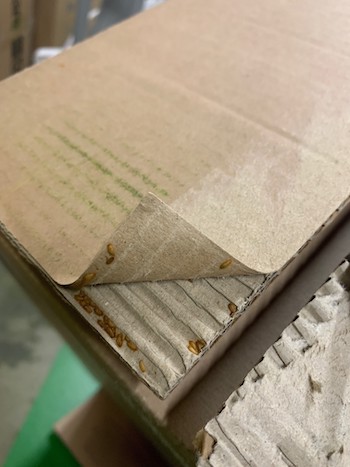 Cardboard provides an ideal hiding spot for khapra beetles and larvae. Photo: Department of Agriculture, Fisheries and Forestry
Cardboard provides an ideal hiding spot for khapra beetles and larvae. Photo: Department of Agriculture, Fisheries and Forestry
While state and federal governments have put many measures in place to reduce the risk of hitchhiker pests such as khapra beetle entering and spreading in Australia, it is impossible to inspect every item that enters the country.
Unlike endemic stored grain pests, khapra beetles do not fly, so the most likely place for them to show up on the farm is not in the stored grain in the silo but in something that humans bring to the farm – for example, in groceries, deliveries or new equipment including household white goods.
To protect your farm, vigilance is vital. Look closely and take care to:
- inspect all goods coming on to your property, including their packaging. The cardboard packaging provides an ideal harbouring space for khapra;
- never assume that machinery is clean – make sure you check it yourself for any grain remaining in the hopper or augers, especially if it is second-hand; and
- undertake regular surveillance of high-risk places where khapra beetle could live and reproduce.
Where to look for khapra beetle on your property
- Home and shed pantries contain many highly attractive foods for khapra beetle, so clean them out regularly and identify any insects found.
- Undertake regular surveillance of stored seed or grain, no matter the source.
- Look out for unusual pests in machinery sheds or any protected spaces where you store goods or equipment.
- Bagged stock feeds or supplements should also be checked for insects.
- If you use sea containers for storage on the property, make sure they are inspected on arrival and regularly while they remain on the property. Remember khapra beetle can remain hiding in cracks and under the floors of sea containers for many years.
What to look for
Khapra beetle are oval-shaped and about 1.6 to 3 millimetres long. They are light-yellow brown to dark brown in colour.
The adult beetles have many fine hairs and indistinct markings on their wing covers. Larvae tend to be larger than the beetle, ranging from 1.6 to 4.5mm long, golden brown in colour, and have distinctive hairs across the body, including longer hairs at the end of the body that resemble a tail.
There are a number of native Trogoderma species in Australia and it can be difficult to distinguish between them and khapra beetle. If you find something similar, it is important to get it identified.
Call 1800 084 881 to report a plant pest.
More information: Kym McIntyre, kym.mcintyre@daf.qld.gov.au

























































